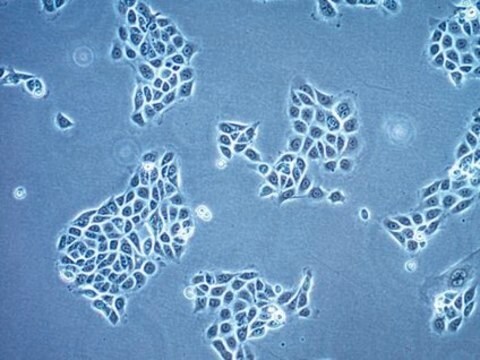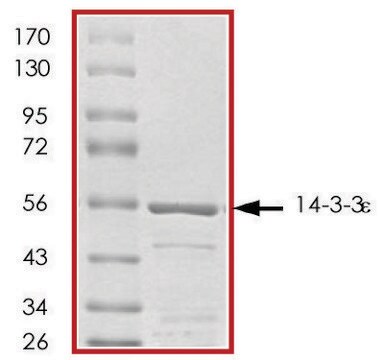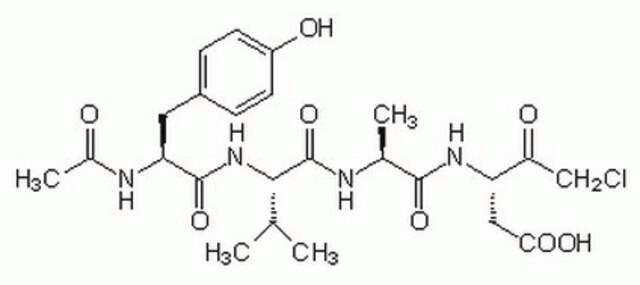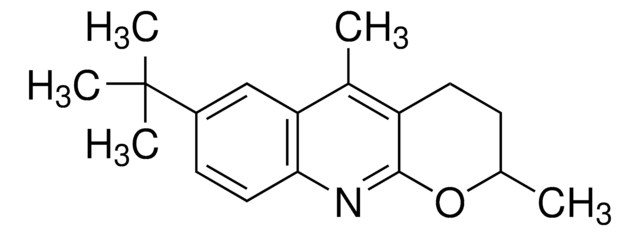SRP5157
14-3-3 θ, GST tagged human
recombinant, expressed in E. coli, ≥70% (SDS-PAGE), buffered aqueous glycerol solution
Synonym(s):
14-3-3, 14-3-3 θ, 1C5, HS1, YWHAQ
Sign Into View Organizational & Contract Pricing
All Photos(1)
About This Item
Recommended Products
biological source
human
recombinant
expressed in E. coli
Assay
≥70% (SDS-PAGE)
form
buffered aqueous glycerol solution
mol wt
~56 kDa
NCBI accession no.
application(s)
cell analysis
shipped in
dry ice
storage temp.
−70°C
Gene Information
human ... YWHAQ(10971)
General description
14-3-3θ (also known as tyrosine 3-monooxygenase/tryptophan 5-monooxygenase activation protein, theta polypeptide) is a member of the 14-3-3 family of proteins which mediate signal transduction by binding to phosphoserine-containing proteins. Through interaction with ASK1, c-jun NH-terminal kinase, and p38 mitogen-activated protein kinase (MAPK), 14-3-3θ plays an important role in controlling apotopsis. Induced expression of 14-3-3θ protein has been reported in patients with amyotrophic lateral sclerosis. Additionally, 14-3-3θ has been observed to mediate nucleocytoplasmic shuttling of the N protein (coronavirus nucleocapsid protein) which causes severe acute respiratory syndrome.
Physical form
Supplied in 50mM Tris-HCl, pH 7.5, 150mM NaCl, 10mM glutathione, 0.1mM EDTA, 0.25mM DTT, 0.1mM PMSF, 25% glycerol.
Preparation Note
after opening, aliquot into smaller quantities and store at -70 °C. Avoid repeating handling and multiple freeze/thaw cycles
Storage Class Code
10 - Combustible liquids
WGK
WGK 1
Flash Point(F)
Not applicable
Flash Point(C)
Not applicable
Choose from one of the most recent versions:
Certificates of Analysis (COA)
Lot/Batch Number
Don't see the Right Version?
If you require a particular version, you can look up a specific certificate by the Lot or Batch number.
Already Own This Product?
Find documentation for the products that you have recently purchased in the Document Library.
Jeffrey M C Lau et al.
Molecular and cellular biology, 27(4), 1455-1466 (2006-12-06)
14-3-3 family members are intracellular dimeric phosphoserine-binding proteins that regulate signal transduction, cell cycle, apoptotic, and metabolic cascades. Previous work with global 14-3-3 protein inhibitors suggested that these proteins play a critical role in antagonizing apoptotic cell death in response
Milan Surjit et al.
Journal of virology, 79(17), 11476-11486 (2005-08-17)
The severe acute respiratory syndrome coronavirus(SARS-CoV) nucleocapsid (N) protein is one of the four structural proteins of the virus and is predicted to be a 46-kDa phosphoprotein. Our in silico analysis predicted N to be heavily phosphorylated at multiple residues.
Our team of scientists has experience in all areas of research including Life Science, Material Science, Chemical Synthesis, Chromatography, Analytical and many others.
Contact Technical Service








